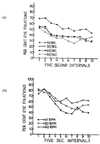Infant visual habituation
- PMID: 18620070
- PMCID: PMC2758574
- DOI: 10.1016/j.nlm.2008.06.002
Infant visual habituation
Abstract
The use of visual habituation in the study of infant cognition and learning is reviewed. This article traces the history of the technique, underlying theory, and procedural variation in its measurement. In addition, we review empirical findings with respect to the cognitive processes that presumably contribute to habituation, studies of developmental course and long-term prediction, as well as recent attempts to address or explain the phenomenon of visual habituation through the use of mathematical or quantitative models. The review ends with an appeal for a return to the study of habituation per se as a valid measure of infant learning, rather than relegating the phenomenon to its use as a technique for familiarizing infants in procedures testing for discrimination or recognition.
Figures



References
-
- Aposhyan HM, Kaplan PS, Peterzell DH, Werner JS. Spatial frequency analysis of infant habituation. Infant Behavior and Development. 1988;11:145–157.
-
- Arana L, Sokolov EN. The stochastic theory of perception: Communication II Perception of elementary figures characterized by different probability of occurrence. Doklady Akademii Pedagogicheskikh Nauk RSFSR. 1961;4:65–69.
-
- Ashmead DH, Davis DL. Measuring habituation in infants: An approach using regression analysis. Child Development. 1996;67:2677–2690. - PubMed
-
- Barry RJ, James AL. Fractionation of respiratory and vascular responses with simple visual stimulation. Physiological Psychology. 1981;9:96–101.
-
- Barten S, Ronch J. Continuity in the development of visual behavior in young infants. Child Development. 1971;42:1566–1571. - PubMed
Publication types
MeSH terms
Grants and funding
LinkOut - more resources
Full Text Sources

